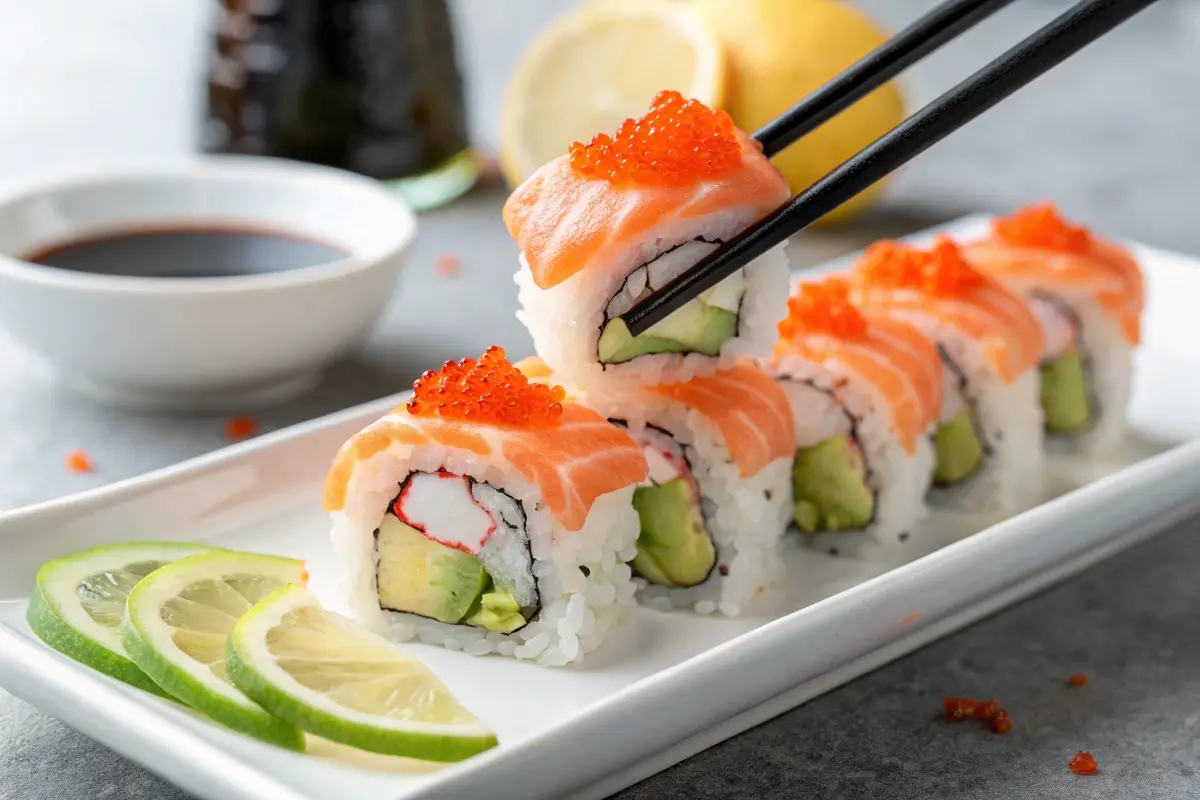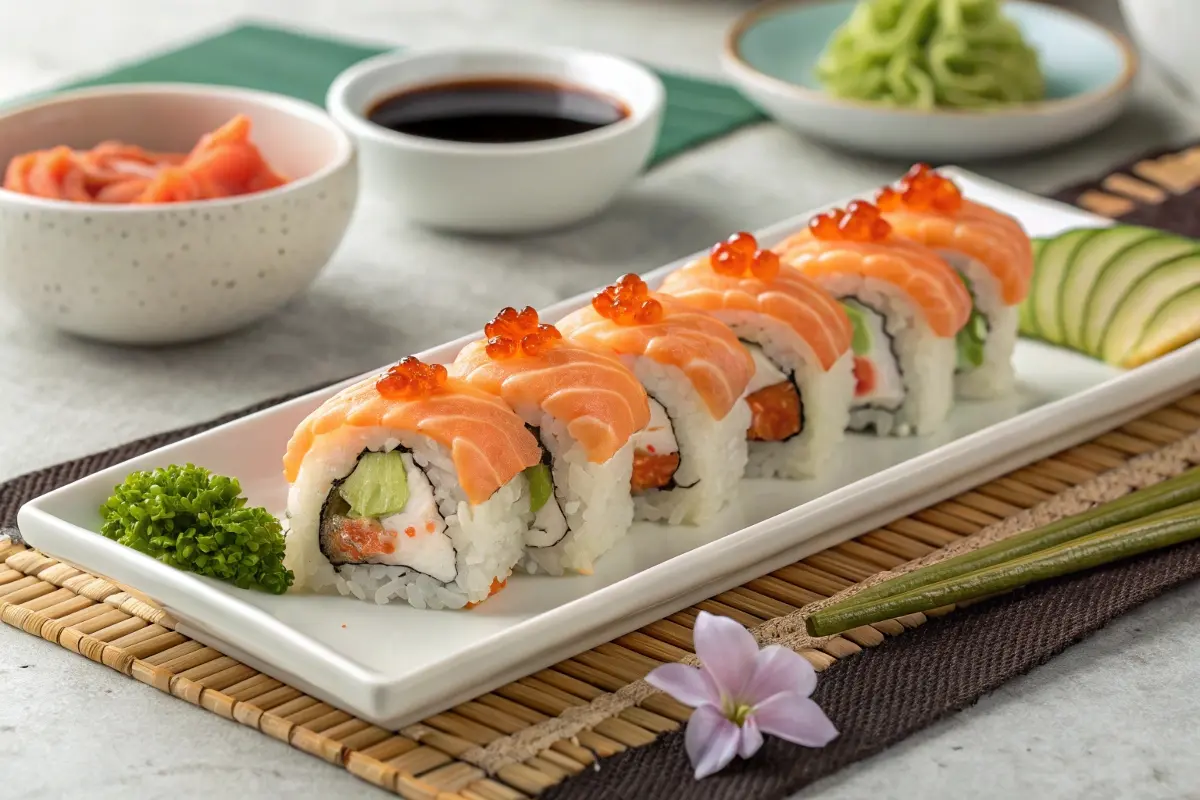What is an Alaska Roll?
Sushi lovers often ask, “Is Alaska roll healthy?” With its combination of fresh salmon, avocado, and cucumber, it seems like a nutritious choice. But is it truly as healthy as it tastes? Let’s dive into its nutritional profile, benefits, and concerns.
This sushi roll is often topped with sesame seeds or masago (fish roe) for added flavor and crunch. While it may not be a traditional Japanese roll, it has earned its place on menus worldwide thanks to its blend of classic sushi ingredients and Western adaptations.

Ingredients Found in an Alaska Roll
Here’s what typically goes into an Alaska roll:
- Salmon: Can be raw or smoked, offering a rich, savory flavor.
- Avocado: Adds creaminess and healthy fats.
- Cucumber: Provides crunch and freshness.
- Rice: Usually white sushi rice, seasoned with vinegar.
- Nori: A sheet of dried seaweed that holds everything together.
- Toppings: Sometimes includes sesame seeds or fish roe for added texture.
Popularity of Alaska Rolls in Japanese Cuisine
Although not a staple of traditional Japanese sushi, Alaska rolls have become a fusion favorite. They appeal to sushi newcomers and aficionados alike because they balance familiar ingredients with the adventurous taste of raw fish. Whether you’re dining at a high-end sushi bar or grabbing a quick bite from a grocery store, you’ll likely find an Alaska roll on the menu.
Nutritional Profile of Alaska Roll
Calories in an Alaska Roll
When evaluating “Is Alaska roll healthy?” it’s important to understand the calories, macronutrients, and vitamins it contains. Each roll typically provides 300-400 calories, along with protein, healthy fats, and essential nutrients.
Protein Content in Alaska Rolls
Thanks to the salmon, an Alaska roll packs a good amount of protein—typically around 15-20 grams per roll. Protein is essential for muscle repair and keeping you full.
Carbohydrates and Fats in Alaska Rolls
Most of the carbohydrates come from sushi rice, with each roll containing about 40-50 grams of carbs. While this might seem high, it’s balanced by the healthy fats from avocado and salmon, providing around 10-15 grams of fat, much of it unsaturated.
Key Vitamins and Minerals in Alaska Rolls
This sushi roll isn’t just about macronutrients. It’s also rich in:
- Omega-3 fatty acids (from salmon) for heart health.
- Vitamin E (from avocado) for glowing skin.
- Vitamin C (from cucumber) to boost your immune system.
- Iodine (from nori) to support thyroid function.
Health Benefits of Alaska Rolls
Omega-3 Fatty Acids from Fish
One way to answer “Is Alaska roll healthy?” is by considering its health benefits. Rich in omega-3 fatty acids, courtesy of salmon, and loaded with vitamins from avocado and cucumber, this roll offers plenty of reasons to enjoy it guilt-free.
Nutrient Density from Avocado and Vegetables
Avocado isn’t just creamy and delicious—it’s also packed with vitamins, minerals, and healthy fats. The cucumber adds hydration and a dose of vitamin C, while nori contributes fiber and iodine.
Low-Calorie and High-Protein Qualities
An Alaska roll is a balanced choice for those watching their waistlines. It’s light, filling, and provides the perfect ratio of protein to carbs, making it a go-to meal for fitness enthusiasts.
Common Health Concerns with Alaska Rolls
Sodium Content in Soy Sauce and Rolls
One downside? The sodium. Soy sauce and sushi rice seasoning can push your sodium intake sky-high. A single serving of soy sauce can contain over 1,000 mg of sodium, nearly half the recommended daily limit!
Solution: Opt for low-sodium soy sauce or skip it altogether. The Alaska roll’s flavors shine on their own!
Risks of Raw Fish Consumption
Raw salmon, while delicious, can carry risks like parasites and bacteria if not handled properly.
Solution: Stick to reputable restaurants or make Alaska rolls at home using fresh, high-quality fish.
Allergies and Food Sensitivities in Sushi Ingredients
From fish to sesame seeds, sushi can trigger allergies in some people.
Solution: Customize your roll to avoid allergens, such as using cooked salmon instead of raw or skipping the sesame seeds.

Recipe for Alaska Roll
Ingredients:
- 1 cup sushi rice (cooked and seasoned)
- 1 sheet nori (seaweed)
- 2 oz salmon (raw or smoked)
- ¼ avocado (sliced)
- ¼ cucumber (sliced into thin strips)
- Sesame seeds or masago (optional)
Preparation Method:
- Place the nori sheet shiny side down on a bamboo mat.
- Spread a thin, even layer of sushi rice over the nori, leaving about 1 inch of the top edge bare.
- Lay the salmon, avocado, and cucumber in a horizontal line near the bottom of the rice-covered area.
- Carefully roll the sushi tightly using the bamboo mat, pressing gently to seal.
- Slice into bite-sized pieces and garnish with sesame seeds or masago. Serve with soy sauce, wasabi, or pickled ginger.
Nutritional Facts of an Alaska Roll (Per Roll)
| Nutrient | Amount |
|---|---|
| Calories | 350 kcal |
| Protein | 18 g |
| Carbohydrates | 45 g |
| Fat | 12 g |
| Sodium | 700 mg |
| Omega-3 Fatty Acids | 1.5 g |
Comparing Alaska Rolls to Other Sushi Rolls
How Does an Alaska Roll Compare to a Boston Roll?
When it comes to sushi rolls, the Alaska roll and the Boston roll are both favorites. But how do they stack up in terms of health?
- Ingredients:
While the Alaska roll contains salmon, avocado, and cucumber, the Boston roll typically features cooked shrimp, cucumber, and sometimes lettuce. Both rolls offer lean protein, but the Alaska roll’s salmon provides more omega-3 fatty acids, which are great for heart health. - Calories:
The Boston roll is slightly lower in calories, with around 280–350 per roll compared to the Alaska roll’s 300–400. This difference largely depends on the use of avocado, which adds more calories but also healthy fats. - Nutritional Value:
The Alaska roll edges out in terms of nutrient density due to the salmon and avocado, which deliver a powerhouse of vitamins and minerals.
“Think of the Alaska roll as the nutrition-packed sibling of the Boston roll—both delicious, but one’s a bit more nutrient-savvy.” 🍣
Healthiest Sushi Roll Options
If health is your priority, here are a few sushi rolls that stand out:
- Cucumber Roll: A low-calorie option for those cutting carbs.
- Avocado Roll: Simple yet rich in healthy fats.
- Rainbow Roll: Packed with a variety of fish for diverse nutrients.
- Alaska Roll: Balanced in protein, healthy fats, and flavor.
Tips for Making Alaska Rolls Healthier
Choosing Low-Sodium Alternatives
One of the biggest pitfalls in sushi dining is the sodium content, primarily from soy sauce and seasonings. To keep things healthier:
- Opt for low-sodium soy sauce or tamari (a gluten-free alternative).
- Season sushi rice lightly to reduce added salt.
Incorporating Brown Rice Instead of White Rice
While white rice is the norm in sushi, swapping it for brown rice can add fiber and nutrients, making your Alaska roll more filling and beneficial for digestion.
“Brown rice gives your sushi a hearty twist without compromising on flavor!” 🌾
Adding More Vegetables for Nutritional Balance
Why stop at avocado and cucumber? Adding extras like carrots, bell peppers, or even spinach can boost your roll’s vitamin content and make it more colorful and crunchy.

Cortado vs. Other Coffee Drinks: Which One to Choose?
When deciding between a cortado and other coffee drinks, it all boils down to your flavor preference. If you enjoy the robust taste of espresso but want it slightly mellowed out, the cortado is a perfect choice. It strikes a balance that highlights the coffee’s natural richness without overwhelming your palate. However, if you’re craving something creamier and more filling, a latte might be your go-to. For a quick, intense coffee experience, a macchiato delivers bold flavor in a compact size. Each drink offers its own charm, so why not try them all and find your favorite? ☕
FAQs About Alaska Rolls and Health
Can You Eat Alaska Rolls on a Diet?
Absolutely! Alaska rolls can fit into most diets, thanks to their balanced mix of protein, healthy fats, and moderate calories. Just watch your portion size and go easy on the soy sauce to keep things in check.
Are Alaska Rolls Gluten-Free?
Not always. While the ingredients in the roll itself are gluten-free, soy sauce and some toppings like masago may contain gluten. To enjoy gluten-free Alaska rolls, use tamari and ensure all ingredients are certified gluten-free.
How Many Alaska Rolls Should You Eat in One Sitting?
Moderation is key. One roll (6-8 pieces) is usually sufficient as part of a balanced meal. Overeating sushi can lead to excessive sodium and calorie intake.
Are Alaska Rolls Safe for Pregnant Women?
Pregnant women should avoid raw fish due to the risk of parasites and mercury. However, Alaska rolls made with cooked salmon or no fish are a safer alternative.
Can You Include Alaska Rolls in a Keto Diet?
Traditional Alaska rolls aren’t keto-friendly because of the rice. However, you can make a keto-friendly version by swapping the rice for cauliflower rice or skipping it entirely.
What Makes Alaska Rolls Stand Out Among Sushi Options?
The combination of salmon, avocado, and cucumber makes Alaska rolls unique. They strike a perfect balance between being flavorful, nutritious, and versatile.
What is a cortado vs. macchiato?
A cortado and a macchiato may both be small espresso-based drinks, but they differ in key ways. A cortado consists of equal parts espresso and steamed milk, creating a smooth and balanced flavor. A macchiato, on the other hand, is a shot of espresso “marked” with a small amount of foamed milk, resulting in a bolder and more intense coffee experience.
Think of the cortado as a harmonious duet, while the macchiato is a bold solo performance! 🎵☕
What is the difference between a latte and a cortado?
The main difference lies in the milk-to-espresso ratio and texture. A latte contains more milk, making it larger and creamier, with a higher ratio of milk to espresso (around 3:1). A cortado, with its equal parts espresso and steamed milk, is smaller and has a more pronounced coffee flavor. If you prefer a robust taste, the cortado is your drink. If you enjoy a creamier, milder experience, go for a latte.
Is cortado strong?
Yes, a cortado is considered strong but balanced. Its equal parts espresso and milk retain the boldness of the coffee while softening its intensity with the creaminess of the milk. It’s perfect for those who want a rich coffee flavor without the overwhelming strength of a straight espresso shot.
Is Alaska Roll Healthy?
So, is the Alaska roll healthy? The short answer is yes—with a few caveats. Its blend of nutrient-rich salmon, creamy avocado, and fresh cucumber makes it a wholesome choice. However, like any sushi, it’s essential to consider portion sizes and limit high-sodium additions like soy sauce.
By making simple adjustments like using brown rice or adding more vegetables, you can enjoy Alaska rolls guilt-free. They’re not just delicious but also packed with health benefits, making them a fantastic option for sushi lovers everywhere.
